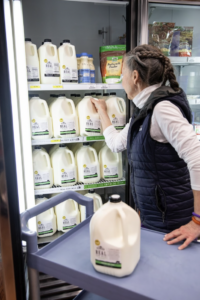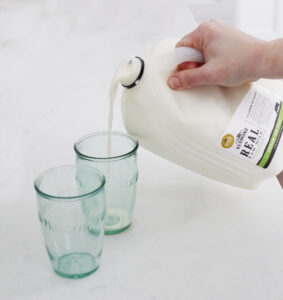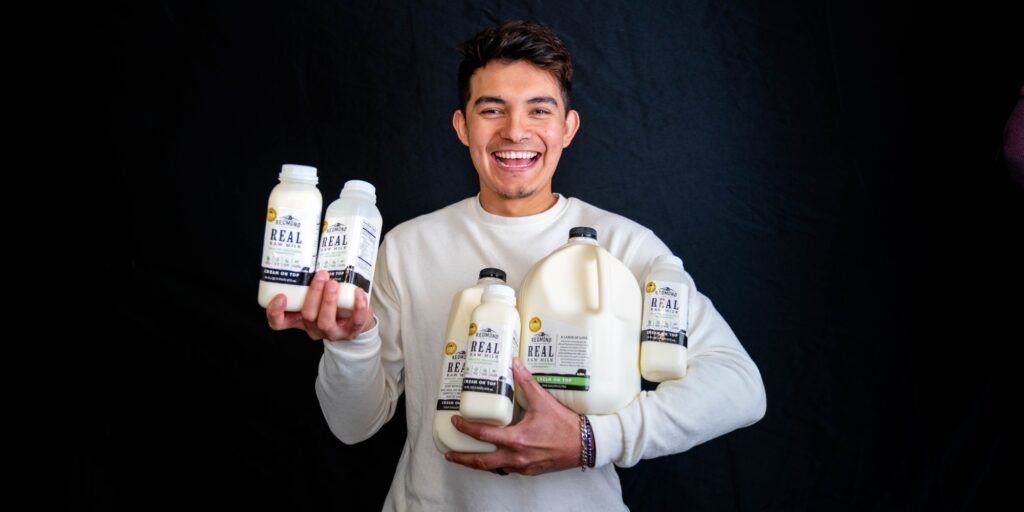A big part of what we do at Redmond Heritage Farms is producing raw milk. That’s one of the main reasons why we got started!
But we’re not the only ones out there selling raw milk. There are plenty of raw dairies around, but not all raw milk is created equal. We don’t mean to toot our own horn, but we believe our raw milk is the best out there.
So why is raw milk beneficial in the first place, and what makes our raw milk special?
Why Raw Milk?

If you haven’t hopped on the raw milk train yet, you should consider it!
Here’s why we believe raw milk is nutritionally superior.
It’s Unpasteurized.
Raw milk is not inherently germy or unsafe. 99% of the time, it’s the conditions in which it’s produced that cause problems.
Raw milk used to be the norm until the overcrowding incommercial farming caused the spread of diseases and pathogens, which got into the milk. So, milk was then pasteurized, or heated to a certain temperature for a certain amount of time, to kill these pathogens and make the milk safe to drink. But pasteurization comes with some downsides.
While pasteurization effectively kills off harmful pathogens, it kills off the good stuff too. Raw milk contains naturally-occurring enzymes and lactase-producing bacteria, which helps digest lactose, a sugar found in milk. This makes raw milk easier for a lot of people to digest. The casein and lactose (a protein and sugar, respectively) in raw milk are in a form people may find easier to process. Raw milk also retains vitamins and minerals that are damaged or destroyed in the pasteurization process. (Vitamin D and zinc, for example).
We’re not saying pasteurization is all bad: it saved lives in a time when it was hard to get clean, raw milk. We’re just saying that it’s also possible to produce raw milk that’s safe to drink and has all its nutrients intact. (More on that that in a minute.)
Non-Homogenized
Raw milk also looks different from the milk you get at the store. There’s a lovely layer of cream on the top, and instead of that bright white color, raw milk is a softer cream color. These traits became undesirable in the early 20th century, so in the 1920’s, homogenized milk became the norm.
Now, most commercial milk is homogenized by being shot through a tiny nozzle at high speeds. This blends the milk so thoroughly that it changes it on a molecular level, causing protein molecules to bind to lipids. The result is milk that lasts longer in the fridge, has a whiter color (as opposed to cream-colored), and doesn’t separate in the bottle. (This is why you don’t have to shake most milk to mix in the cream.)
The effects of homogenization on the body are hotly debated, but many people find homogenized milk more difficult to digest. This could be because homogenization renders the molecules into something your body may not recognize or know how to process. After all, milk doesn’t look like that in nature.
Non-homogenized milk leaves the natural molecular structure intact. And personally, we love that layer of cream on the top!
The Way Nature Made It
A lot of the evidence about raw milk nutrition is inconclusive. However, we believe that nature does it right.
Raw dairy products have been an important part of the diets of many healthy cultures for thousands of years, and we think there’s a reason for that. For the most part, we believe food is the most nutritious when it’s as close to its natural state as possible. (That said, the nutrients in some foods become more bioavailable after cooking, fermenting, sprouting, etc. But that’s another article for another day.)
We also care about people’s subjective experiences. Lots of customers claim raw milk helps their gut, immune issues, respiratory issues, etc. We don’t base our practices solely on anecdotal evidence, of course, but we don’t disregard these stories either.
We trust customers to do what’s best for themselves. We want our community to feel empowered to make the right choices for their families.
We share what we know, maintain transparency, and leave the rest up to you!
Why is our milk different?

When it comes to our raw milk, we strive to get the best of all worlds: clean, safe, nutritious milk in its natural form.
This means we focus on two things: nutritional density and raw milk safety.
Here’s how we do that.
Nutritional Density
We start by prioritizing our herd’s diet. We feed our cows a mixture of organic alfalfa hay, pasture when it’s available, a small amount of barley (usually as treats on their way to be milked), and supplements of Redmond Real Salt and conditioner for mineral support.
All the nutritional goodness in our cows’ feed increases the nutrients in the milk, including vitamins, minerals, and healthy fats.
Our herd is also entirely A2/A2 and produces A2 milk, which many people find easier to digest.
Keeping our herd as healthy as possible is a double whammy because it increases the nutritional value while reducing the likelihood of pathogens in the milk. Healthy animals = healthy food!
Animal Health
Our cows also receive the best veterinary care to catch health issues early on before they become big problems. We don’t give our cows any artificial hormones, and we use antibiotics only in life-or-death situations. (And if we have to take those measures, we take that cow off the milking line until the antibiotics have completely worked through its system and the milk is clean again.)
Also, just between us, we believe the way an animal is treated has an impact on the final product. We feel that the way the animals are treated matters. Stress causes health problems that can impact the milk. And at the end of the day, treating our animals well is also the right thing to do, plain and simple.
Safety and Testing
There are always risks associated with consuming raw foods, including dairy products. But we take every precaution to ensure that the milk on our shelves is safe to drink.
For starters, we chill the milk immediately after milking to prevent the growth of bacteria or other harmful pathogens.
Every single batch of milk is triple-tested at both an internal lab and two independent state-certified labs for the presence of bacteria and other pathogens to make sure our milk meets or surpasses the requirements for raw or pasteurized milk.
Each batch of milk goes through two separate bacteria tests and a pathogen test.
The first test is a Standard Plate Count, or SPC, which measures the total amount of bacteria colonies. Utah state law requires milk to be under 20,000 bacterial colony units. Our milk usually clocks in at fewer than 1,000 units.
The second test is the coliform test, which looks for environmental bacteria that may have found their way into the milk. In Utah, milk is required to be under 10 coliform colonies, which is incredibly strict. However, our milk averages 1.
Finally, the milk is tested for the presence of pathogens, including:
- Salmonella
- E.coli (0157)
- Listeria
- Campylobacter
In addition to regular inspections, the Utah State Health Department performs monthly tests of the health of our herd through a process called SCC (Somatic Cell Count). Our herd is also tested annually for tuberculosis.
Finally, every batch of milk is tested for antibiotics.
In the rare cases that we don’t pass these tests, the milk is disposed of on the farm and is not shipped to our stores.
Every jug of milk that makes it to our shelves has undergone all these tests and passed with flying colors!
Cleanliness
We thoroughly and consistently clean our tank and entire milking system to minimize the possibility of bacteria entering the milk. We also clean our cows’ udders before each milking.
This is also why we don’t bottle our milk in glass. The containers have to meet our standards, and reused glass may not be clean. It would also drive up costs with additional testing, sanitization, etc. We encourage you to recycle your raw milk jugs (after a thorough rinse)!
We Don’t Settle for Less Than the Best
We don’t cut any corners when it comes to the quality and safety of our milk. We do everything we can to bring you the best raw milk possible!

